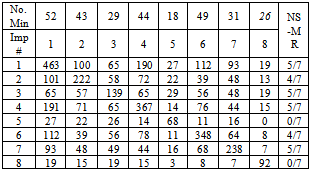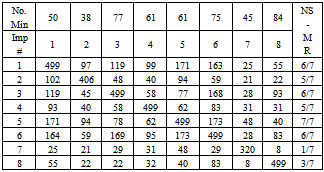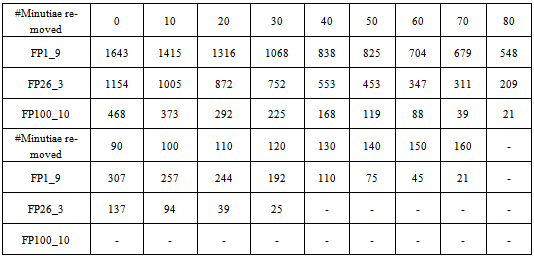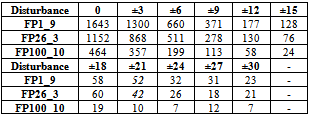-
Paper Information
- Previous Paper
- Paper Submission
-
Journal Information
- About This Journal
- Editorial Board
- Current Issue
- Archive
- Author Guidelines
- Contact Us
Computer Science and Engineering
p-ISSN: 2163-1484 e-ISSN: 2163-1492
2012; 2(3): 37-42
doi: 10.5923/j.computer.20120203.06
A Study of Distortion Effects on Fingerprint Matching
1Department of Criminal Justice & Security Systems, Farmingdale State College, Farmingdale, NY 11735, USA
2Department of Computer Science, College of Staten Island, Staten Island, NY 10314, USA
Correspondence to: Qinghai Gao, Department of Criminal Justice & Security Systems, Farmingdale State College, Farmingdale, NY 11735, USA.
| Email: |  |
Copyright © 2012 Scientific & Academic Publishing. All Rights Reserved.
Fingerprint matching often suffers from non-linear distortion. In this paper, we study the distortions of the fingerprints in three public available databases. To simulate the real scenarios of fingerprint matching, we distort fingerprint minutiae templates with the following three methods: 1) Randomly remove certain number of minutiae; 2) Randomly replace certain number of minutiae; 3) Randomly disturb the locations and orientations of the minutiae. Our experimental results show how and to what extent the fingerprint minutiae templates can be distorted without causing increases in false non-match rates and false match rates.
Keywords: Fingerprint, Database, Distortion, Minutiae, Template, Removal, Replacement, Identification, Matching
Article Outline
1. Introduction
- Fingerprint recognition is one of the most widely used biometric technologies in criminal investigation, physical access control, and commercial applications. Like other biometric technologies, fingerprint verification system works with two stages: registration and identification. During registration a user’s fingerprint will be measured to obtain biometric images, from which a template is extracted and stored in a database. During verification, the person must provide the same finger for new measurements. A new template will be obtained and then compared with the stored template. The matching score will be compared with a predefined threshold to determine if they match. Currently most fingerprint verification systems are based on level-2 features: minutiae points (ridge bifurcation and ending). As Bazen & Gerez described in[3], there are four problems in matching the two sets of fingerprints: (1) there are false, missed and/or displaced minutiae; (2) they are only partially overlapped; (3) they may be translated, rotated and scaled; and (4) there exist plastic distortions or deformations.Nonlinear distortions of fingerprint are unavoidable when capturing the images of a live finger with a 2D contact sensor because of the elasticity of the skin, contact pressure, finger displacement, skin moisture content, imaging methods, sensor noise, etc. To cope with the non-linear distortion, Chen et al.[1] proposed using local minutiae triangle based feature sets to measure the similarity between deformed fingerprints. The triplets of minutiae are constructed with the sole restriction of distance between any pair of minutiae. Each minutia may belong to many triangles. Each triangle isrepresented with a 12-dimension vector containing distances, orientations, and angles related to the three minutiae. It is believed that the local triangle feature vector is independent of some distortions including the rotation and translation of the fingerprint. Cao et al.[5] proposed using fingerprint placement direction and ridge compatibility to handle fingerprint distortions. Uz et al.[7] proposed a template synthesis algorithm based on Delaunay triangulation. It creates a super-template by combining minutiae from multiple impressions of a finger to increase coverage area, restore missing and eliminate spurious minutiae. Singh[9] et al. developed an image deformation correction algorithm which uses phase congruency-based information to handle geometric deformation. Cappelli et al.[10] constructed elastic distortion model to simulate the nonlinear deformations of fingerprint images. Jain and Watson et al.[15] designed three types of distortion filters to process fingerprints. Senior and Bolle[16] proposed an approach to mapping fingerprint image into a canonical representation to remove distortion.A few researchers proposed using the Thin Plate Spline (TPS) based model to handle fingerprint distortion. Ross et al.[2][6] developed an average deformation model based on minutia point correspondences between pairs of impressions from same finger. This model is then used to help align the minutiae set of a registered template with that of a query image. Bazen & Gerez[3] proposed a minutia matching algorithm that models elastic distortions, based on the locations and orientations of the extracted minutiae. The elastic minutiae matching algorithm estimates the non-linear transformation model in two stages: local minutiae neighborhood comparison and global matching. Ross et al.[8] used image mosaicking and feature mosaicking to handle the non-linear distortions between two impressions of a finger. Chen et al.[4] proposed constructing an average deformation model from a set of fingerprints, which will be applied to pre-distort a template prior to matching. A TPS model is utilized in all these proposals.Recently, touchless 3D fingerprint scanner becomes available. Since touchless 3D fingerprints do not contain distortions, they have to be distorted during the unrolling process to match the legacy 2D contact fingerprints[14]. Zhao et al.[11] proposed approach to unrolling and distorting 3D fingerprints to solve the interoperability issue between 2D and 3D fingerprint systems[13]. Distortion can also be used to prevent fingerprint system from being attacked. Antonelli et al.[12] proposed an approach to detecting fake fingerprint by using skin distortion.In spite of all these efforts and special applications, it remains a challenging problem to effectively solve the distortion problems of fingerprint and other biometrics.Our ContributionIn this paper we first study the distortions of the fingerprints from three publicly available databases: FVC2002[18], FVC2004[19], and CASIAv5[20]. Then, we distort fingerprint minutiae templates with the following three methods to simulate the real scenarios of fingerprint verification (or identification):● Randomly remove certain numbers of minutiae from a template;● Randomly substitute certain numbers of minutiae in a template;● Randomly disturb the locations and orientations of the minutiae in a template.With experimental results we show to what extent the fingerprint minutiae templates can be distorted without causing increases in false non-match rates and false match rates.Organization of the PaperThe rest of the paper is organized as the following. In section 2 we describe the fingerprint template matching algorithm. Section 3 gives the experimental results. Section 4 concludes the paper.
2. Methods
- Fingerprint minutiae are points of ridge ending and ridge bifurcation. Each point is represented with triple (x, y, θ); where (x, y) is a minutia’s Cartesian coordinates, and θ is the orientation of ridge flow. Each fingerprint template consists of a number of such minutiae. The matching algorithm consists of three major steps as given in[17]: Transform the set of (x, y, θ) values into rotationally invariant graph; iteratively search for compatible subsets/subgraphs; compute the match score between the two graphs based on heuristically defined tolerances.More details can be found in[17]. All the matching results are obtained with this popular matching algorithm.As mentioned before, biometric based identification system works with two stages: registration and verification. For fingerprint minutiae based system, three scenarios may happen during these stages due to distortions:● Reduction: minutiae that exist at registration might disappear at verification● Substitution: some registered minutiae may be replaced by non-existing minutiae upon registration might disappear at identification● Alteration: minutiae locations and orientations may change upon verificationWith these in mind we conducted three different experiments: ● Randomly remove minutiae from the original template. Then match the original template with the modified template● Randomly substitute some minutiae in the original template. Then match the original template with the modified template● Alter minutiae coordinates and orientations. Then match the original template with the modified templateThe experimental results are given below.
3. Results
- To compare the distortion effects of different fingerprint databases, we firstly conduct the experiments with fingerprints from the following three databases: DB1B from FVC2002[18], DB1B from FVC2004[19], and CASIAv5 [20]. From each of the databases, we arbitrarily select one finger, which has a number of impressions (fingerprints), and match its impressions against each other with the NIST fingerprint software[22]. The predefined matching threshold is 40. That is to say, if a matching score between two impressions (fingerprints) is greater than or equal to 40, they match. Otherwise, they do not match. Given two fingerprints A and B, theoretically the matching score when A is designated as the probe fingerprint (P) and B as the gallery fingerprint (G) should be the same as the score when B is designated as the gallery fingerprint (G) and A as the probe fingerprint. However, the matching results with NIST fingerprint software[22] do show trivial differences. Therefore, we listed the matching scores for both matches.
3.1. Impressions vs. Impressions
- In this section, we study the fingerprint impressions from the following three databases: DB1_B from FVC2002[18], DB1_B from FVC 2004[19], and CASIAv5[20].
3.1.1. Finger #102 from DB1_B FVC2002
- Figure 1 shows the 8 impressions of Finger #102 from DB1_B, FVC2002[18]. The numbers of minutiae for each impression and their non-self mutual matching scores are given in Table 1 (No. Min: Number of minutiae; Imp#: Impression #; NS-MR: Non-self Match Rate).In Table 1, the total number of non-self matches (i.e., match scores are greater than 40) is 28 out of the 56 pairs. Therefore, the overall match rate is 28/56=50%.By looking at the fingerprints in Figure 1, we can see that impression #102_5 only contains the upper fragment image of the finger, while impression #102_8 significantly shifts its core to the right-hand side such that the fingerprint regions around the delta are completely gone. As a result, both impression #102_5 and impression #102_8 match none of other impressions, as given in Table 1. The results show that image fragmentation can seriously degrade matching performance.
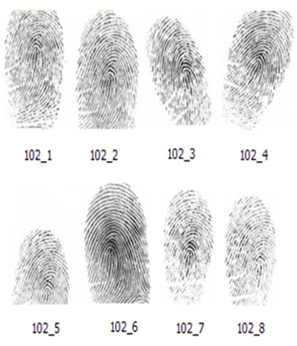 | Figure 1. Finger #102, 8 impressions, DB1_B, FVC2002[18] |
|
3.1.2. Finger #107 from DB1_B FVC2004
- Figure 2 gives 8 impressions of Finger #107 from DB1_B, FVC2004[19]. The matching scores among them are given in Table 2.
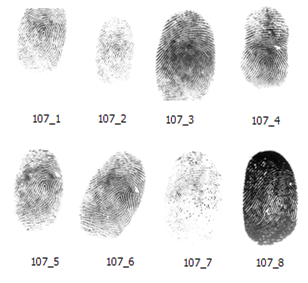 | Figure 2. Finger #107, 8 impressions, DB1_B, FVC2004[19] |
|
3.1.3. Finger #91_L2 from CASIAv5
- Figure 3 gives 5 impressions of Finger #91_L2, CASIAv5[20], from which we can see that each impression only covers one portion of the fingertip. Table 3 gives the mutual matching scores. From Table 3 we can see that the non-self match rates for all five impressions are zeros.
 | Figure 3. Fingerprint 91_L1, 5 impressions, CASIAv5[20] |
|
 | Figure 4. Matching results of fingerprint impressions vs. database |
3.2. Impressions vs. Database
- The results are plotted in Figure 4. Note that the original DB3A of FVC2006 contains 1680 images, while CASIAv5 contains 20,000 images. Even though every impression is matched against a database separately, we plotted the matching results for all the impressions belonging to one finger into one graph for comparison. From Figure 4 we can see that all the matching scores are lower than 40, the threshold, i.e., the distorted impressions do not cause any increase in FMR.
3.3. Effects of Minutiae Removal
- To simulate the real scenario of losing minutiae at verification, we distort fingerprint template by randomly removing minutiae from the original template. The resultant template will be matched against the original template. We carry out the experiment with the following three fingerprints from DB3_A FVC2006: FP1_9 (180 minutiae), FP26_3 (142 minutiae), and FP100_10 (102 minutiae). The results are given in Table 4 and plotted in Figure 5.With threshold 40, we summarize the results in Table 5, which shows that the distorted templates can successfully match its original template as long as it contains 40 original minutiae.
|
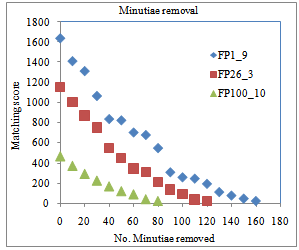 | Figure 5. Matching results of randomized minutiae removal |
|
3.4. Effects of Minutiae Replacement
- At verification some new minutiae may be produced while some old minutiae (existed at enrollment) may disappear. To simulate this scenario we distort a template by randomly removing some existing minutiae and then randomly inserting the same number of non-related new minutiae. Therefore, the resultant template contains the same number of minutiae as its original template. The results are plotted in Figure 6.
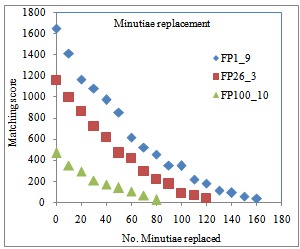 | Figure 6. Matching results of randomized minutiae replacement |
|
3.5. Effects of Minutiae Disturbance
- The distortion of fingerprints is reflected not only by the minutiae reduction and minutiae replacement, but also by the changes in minutiae positions and orientations. To simulate this scenario we randomly modify the parameters (x, y, θ) of all minutiae. The modified minutiae would have new parameters (x ± dx, y ± dy, θ ± dθ). The values of dx, dy and dθ are randomly generated and independent from each other. The disturbances and the matching results for the three fingerprints are given in Table 7 and plotted in Figure 7, in which the horizontal axis represents dx, dy and dθ.
|
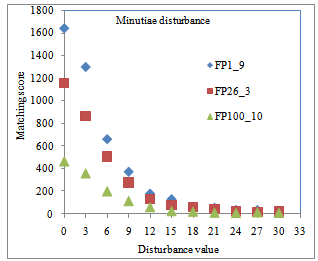 | Figure 7. Matching results for minutiae disturbance |
4. Conclusions
- In this paper we investigated the distortion effects on fingerprint matching, which is conducted with the most popular and authoritative fingerprint matching software published by NIST (Refer to[22]). Specifically, we looked at the distorted fingerprints from three fingerprint databases: DB1B of FVC2002, DB1B of FVC2004, and CASIAv5. Testing results show that fingerprints in CASIAv5 are most significantly distorted and that the distortions increase FNMR, but has no effects on FMR, based on the given threshold 40. We simulate fingerprint distortion with three methods: (1) Randomly remove certain number of minutiae from a template; (2) Randomly replace certain number of minutiae in a template; (3) Randomly disturb the locations and orientations of the minutiae in a template. The experimental results of the randomized removal show that 40 original minutiae should be kept in a template, while those of the randomized replacement indicate that only 30 original minutiae are needed for successful matching. Minutiae disturbance tests show that templates containing more minutiae have better distortion tolerance.
ACKNOWLEDGEMENTS
- Xiaowen Zhang was supported in part by the PSC-CUNY Award 64561-0042.Portions of the research in this paper use the CASIA-FingerprintV5 collected by the Chinese Academy of Sciences' Institute of Automation (CASIA).
 Abstract
Abstract Reference
Reference Full-Text PDF
Full-Text PDF Full-Text HTML
Full-Text HTML